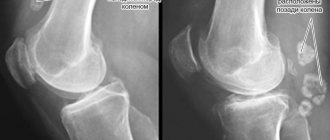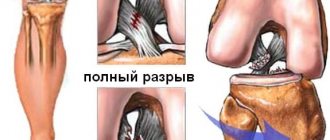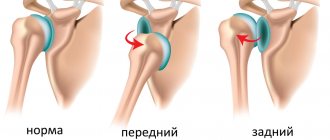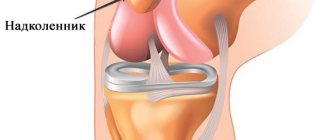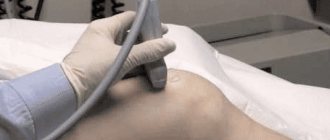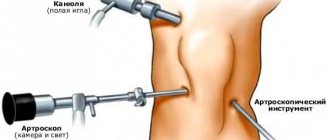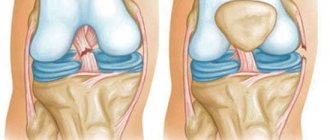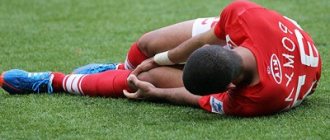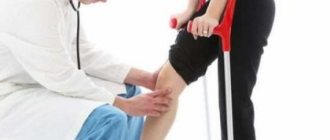Patellar tendinitis is an inflammation of the patellar tendon, which runs between the kneecap and the tibial tuberosity. For its diagnosis and treatment, all conditions have been created at the Yusupov Hospital:
- European level of comfort;
- Equipment from leading global manufacturers;
- Individual approach to the choice of therapeutic tactics for each patient;
- Application of modern surgical treatment methods according to indications;
- Attentive attitude of medical staff towards patients and their relatives.
The patellar tendon plays a key role in the use of the muscles of the lower extremity. It allows you to straighten your knee, allowing you to push a ball, jump and run uphill. Tendonitis of the patellar ligament most often occurs in athletes involved in sports that involve frequent jumping: volleyball, basketball. Knee tendinitis can also develop in people who do not exercise. After an unsuccessful turn of the leg, they may develop a partial rupture of their own patellar ligament and an inflammatory process may occur.
Symptoms of patellar tendinitis
The first sign of patellar tendonitis is pain. It is usually localized in the area that is located between the patella and the attachment of the tendon to the tibia. Pain in the knee joint initially appears only during physical activity or after intense exercise. It can intensify to such an extent that it reduces sports and physical activity. Ultimately, the patient is unable to climb stairs or get out of a chair independently.
If you ignore the warning signals the body is sending and try to continue working, the tendon rupture will increase. Pain localized in the patella area intensifies with flexion and extension of the knee, or displacement of the kneecap by hand. Swelling appears in the area of the knee joint, limitation of movements, and a feeling of weakness in the thigh muscle. If factors that contribute to the development of patellar tendonitis are not addressed, knee pain and decreased function may persist. In this case, the disease will progress and patellar tendinopathy will develop. If pain in the knee joint occurs, it is necessary to implement self-help measures, namely: apply an ice pack to the affected area and temporarily reduce the activity that causes pain, or completely abandon it.
The proper patellar ligament originates from the lower edge of the kneecap and attaches to the top of the tibia (tuberosity). This ligament plays an important role in extension of the knee joint (straightening the leg).
Tendinitis (inflammation) of the patellar ligament is considered a typical representative of overuse diseases. It occurs more often in athletes: weightlifters, sprinters, jumpers, which is where it gets its second name “jumper’s knee.” The inflammation is based on repeated trauma to the ligament during stress, which is more common in jumping sports (running, volleyball, basketball, boxing), cycling and contact martial arts, where there are kicks. The disease occurs between the ages of 16 and 40 years, and is slightly more common in men. Flat feet with pronation of the foot can contribute to the occurrence of inflammation, since in this condition the lower leg twists slightly and the tension of the ligament increases.
In addition, the surface on which training or sports take place can contribute to inflammation of the patellar ligament. Thus, about more than half of the cases of the disease occur in people involved in sports or training on hard surfaces. Of course, excessively long training contributes to the development of the disease. The angle of flexion in the knee joint at which the load occurs is important: the ligament is most tense in the flexion amplitude from 30 to 60 degrees. Thus, all sports where frequent jumping and landing, acceleration and braking occur are at risk.
Patellar tendonitis can occur not only in athletes, but also in ordinary people, usually over the age of 40. With age, degenerative changes accumulate in the tendon (the ligament “gets old”) and it can no longer withstand stress as successfully as before. Accordingly, micro-tears and inflammation occur.
Typically, patients complain of pain in the area of the lower part of the patella, that is, at the site of attachment of the ligament. In addition, pain can also occur at the site of fixation of the ligament to the tibial tuberosity, although this symptom is less common. In the early stages, pain after physical activity is typical. As the disease progresses or becomes chronic, pain may occur during and before exercise. Usually the pain is dull, localized along the ligament or slightly to the sides of it. With progressive tendinitis, attacks of more intense pain may occur during exercise. In addition to pain, the disease can manifest itself as stiffness, tension, or weakness of extension in the knee joint.
Sometimes, to rule out other causes of knee pain, such as pain from injuries and tears of the menisci, especially in the anterior parts, magnetic resonance imaging (MRI) can be useful, which allows you to see soft tissues (menisci, ligaments, tendons, cartilage , muscles, etc.). In patients with patellar tendonitis, MRI often shows increased signal at the inferior pole of the patella and in the ligament itself, but the signal intensity does not always correspond to the severity of symptoms. In some cases, with tendonitis, the ligament may be thickened on MRI.
Magnetic resonance imaging for patellar tendonitis.
Due to its superficial location, the patellar ligament is accessible for ultrasound. An experienced physician can detect ligament thickening, degenerative changes, and partial and complete tears. During the regeneration stage, an increase in blood flow can be recorded on ultrasound with Doppler sensors.
Typically, during an exacerbation, the complex of conservative treatment includes: exclusion of physical activity (long walking, running, jumping), ice, light massage, physiotherapy, physical therapy, non-steroidal anti-inflammatory drugs. Special orthotic bandages and kinesio taping are used.
Kinesio taping for patellar tendonitis.
An effective treatment method is shock wave therapy.
Shock wave therapy for patellar tendonitis
If conservative treatment is ineffective, surgery is indicated. The operation consists of excision of non-viable sections of the ligament
Diagnosis of knee tendinitis
If pain after a knee ligament injury persists or worsens, interferes with your ability to perform daily activities, or is accompanied by swelling or redness around the joint, you should consult a doctor. He will conduct a physical examination and determine the degree of dysfunction of the knee.
To examine the severity of the tear and determine whether the kneecap is in the correct position, the doctor will order an x-ray or magnetic resonance imaging. Using ultrasound, changes in the tendons and the patellar ligament are detected. This allows for a timely implementation of a set of conservative measures aimed at preventing tendinitis of the knee joint.
Features of patellar dislocation
Patella dislocation is a fairly common injury that occurs as a result of a fall on the knee or an impact, usually in the presence of corresponding anatomical features. Usually occurs in the outer (lateral) direction. In this case, a rupture of the patellar ligament and disruption of the cartilaginous structures may occur. Factors that contribute to the occurrence of pathology quite often go unnoticed until the incident itself, and do not manifest themselves in any way. Most often, injuries occur at a young age, mainly in females. This is due to the characteristics of the knee joint. People with existing valgus deformity of the lower extremities (x-shaped) or connective tissue dysplasia are more susceptible to dislocation.
Treatment of tendonitis of the patellar tendon
The main principle of treatment for tendonitis of the patellar tendon is its early onset. Tendons and ligaments have fairly poor nutrition. Over time, pathological changes occur in their tissue, which worsens the prognosis for recovery. Rheumatologists prescribe the following conservative treatment for patellar tendinitis:
- Unloading the knee by using a knee brace or fixing bandage;
- Limitation of physical activity;
- Cold on the joint during the first 24 hours after the onset of pain;
- Non-steroidal anti-inflammatory drugs for pain relief;
- Troxevasin ointment to reduce swelling in the joint area.
In the acute stage of the disease, the patient is recommended to lie down with a cushion under his leg. You can move around using a cane. In severe cases, injections of glucocorticoids into the source of pain are used. This technique is not used to treat athletes, since hormonal drugs can cause progression of degeneration of the patellar ligament and lead to its rupture under load.
Surgical methods for the treatment of tendinitis of the knee joint ligaments are resorted to in the absence of a positive result from conservative therapy carried out for 1.5 - 3 months. During the operation, the patellar ligament is inspected, the damaged tissue is carefully excised, and the ligament is fixed with a special screw to the tibia.
The main types of patellar displacement
In medicine, such types as traumatic and congenital dislocation are known; in addition, it is customary to distinguish acute and chronic (old) forms. If such an injury occurs periodically, they speak of a habitual type of injury.
In addition, there are differences depending on the direction of the displacement:
- Vertical - rotation occurs around its axis horizontally and is accompanied by entry into the joint space.
- Rotational, when the “bowl” rotates along a vertical axis.
- Lateral – occurs when a fall occurs and there is a strong blow to the lateral surface of the knee, accompanied by displacement of the patella to the side (the most common).
Diagnostics
The doctor interviews the patient, finds out the peculiarities of his life, listens to complaints and conducts an examination.
The patient receives a referral for an x-ray to rule out calcification of the ligament and fractures associated with chronic overexertion. However, x-rays do not reveal signs of tendinitis itself.
MRI helps evaluate the condition of the ligament and surrounding tissues.
MRI for patellar tendinitis
Manifestations
Violation of the anatomical integrity of the patella has quite characteristic clinical signs that appear immediately after the damage. These include:
- Severe pain in the area of violation of the anatomical integrity, which intensifies when trying to perform movements in the knee.
- Redness (hyperemia) and swelling of the skin and subcutaneous tissue in the area of traumatic injury, which is a sign of the development of an inflammatory reaction.
- Violation of the functional state of the knee, which is manifested by limitation of movements in it.
- Change in shape (deformation) of the kneecap area.
The severity of these clinical manifestations depends on the severity of the violation of the anatomical integrity, as well as a possible combination with damage to other structures of the knee.
Disease prevention
To avoid the development of mechanical tendinitis, certain rules should be followed:
- Avoid putting excessive stress on your knee joints.
- Don't increase the intensity or frequency of your workouts too suddenly.
- Jogging should only be done on special paths or on a dirt road, but not on asphalt.
- Always treat any bruises or sprains to the end. If you stop following your doctor's instructions once the pain goes away, the smoldering inflammation inside the joint may remain and eventually lead to tendonitis.
- Recover properly after intense sports activities: take hot baths with eucalyptus or sea salt, go to the bathhouse, or have a massage.
- It will be useful to apply therapeutic mud to your knees, so it is recommended to visit sanatoriums that provide this opportunity.
To prevent degenerative tendinitis you should:
- Even in the absence of the disease, perform the therapeutic exercises described in the article above. Before doing this, be sure to consult your doctor to make sure there are no contraindications.
- To strengthen ligaments and tendons, drink enough clean water (30 ml per 1 kg of body, for example, if you weigh 70 kg, you need 2.1 liters of water per day).
Dietary recommendations
To avoid the disease, you must:
- there are foods that help strengthen ligaments and tendons;
- exclude from the menu foods that adversely affect them.
| Healthy foods | Harmful foods (possibly rarely consumed in small quantities) |
| Gelatin, cartilage, seaweed - contain large amounts of mucopolysaccharides, which improve joint function | Carbonated drinks, flour, processed cheese, crab sticks, smoked meats and pickled foods contain phosphates of inorganic origin, which contribute to the development of joint diseases |
| Green vegetables, raisins, dried apricots, dates, prunes - contain magnesium It is needed for the proper functioning of the nervous system, including the nerves that are “responsible” for the functioning of muscles, ligaments and tendons | Sorrel, radishes, spinach - contain oxalic acid, which disrupts the process of supplying joints with nutrients |
| Fish (especially salmon and trout), seafood - contain iron, which helps remove excess inorganic phosphorus from the body | Chocolate, coffee, pork, liver, lentils - contain purines, which adversely affect the musculoskeletal system |
| Dairy products are rich in natural calcium, which strengthens bones, muscles, joints and ligaments |
Such nutrition will help maintain the health of the musculoskeletal system and avoid not only tendinitis, but also osteoporosis, arthritis and other diseases.
If you don’t know how to include foods that you need to eat in your diet and what to replace those that are not recommended for consumption, then it is better to contact a nutritionist to formulate a detailed nutrition plan.
This is especially important if you play sports, since your body, due to increased stress, requires exclusively proper and balanced nutrition.
